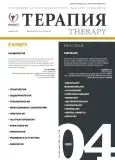Myocardial infarction in young men: androgen levels and predictors of post-hospital adverse cardiovascular events
- Authors: Tkachenko V.V.1, Tuev A.V.1, Karpunina N.S.1, Shishkina E.A.1
-
Affiliations:
- Academician E.A. Wagner Perm State Medical University of the Ministry of Healthcare of the Russia
- Issue: Vol 9, No 4 (2023)
- Pages: 22-29
- Section: ORIGINAL STUDIES
- URL: https://journal-vniispk.ru/2412-4036/article/view/274006
- DOI: https://doi.org/10.18565/therapy.2023.4.22–29
- ID: 274006
Cite item
Abstract
Myocardial infarction (MI) remains one of the leading causes of morbidity and mortality worldwide, including in young men.
The aim of the study was to determine the risk factors for recurrent MI in young men with normal and reduced testosterone levels, taking into account the angiographic patterns.
Material and methods. The total amount is of 99 men aged 25 to 44 years, group I includes 60 patients with STEMI and the phenomenon of slow coronary blood flow (SFC), group II includes 39 patients with STEMI and atherotrombotic occlusion of the coronary artery. During the admission together with the routine examination, the levels of testosterone, cortisol, sex steroid-binding globulin and free testosterone were measured. To evaluate the long-term outcomes after index MI (12 months after) multivariate prognostic models were used.
Results. A year after the index MI, there was a failure to achieve the target blood pressure in 45,6% and 51,7% in both groups, the target LDL level in 40,4% and 72,4%, respectively. There were no deaths in the groups, a new MI was registered in 10 and 16 men from groups 1 and 2. It was found that for men with normal testosterone levels, regardless of the angiographic pattern, the risk of MI increased with a decline in cortisol levels, with neutrophil-lymphocyte ratio (NLR) growth and the number of affected arteries, CI: 0,69–0,94, model sensitivity – 86,4%, specificity – 87,5%, p=0,004. The risk of MI for men with low testosterone levels increased with ejection fraction reducing and with an increase in NLR and LDL cholesterol, CI: 0,53–0,83, sensitivity – 67%, specificity – 38%, p=0,001.
Conclusion. As with the saved and with a reduced level of testosterone, the predictors of adverse cardiac events (a new MI) made a combination of atherogenic dyslipidemia with the activity of latent inflammation. In addition, the need to improve further work to achieve the target values of blood pressure and LDL in patients with STEMI has been highlighted.
Full Text
##article.viewOnOriginalSite##About the authors
Vyacheslav V. Tkachenko
Academician E.A. Wagner Perm State Medical University of the Ministry of Healthcare of the Russia
Author for correspondence.
Email: vvtkachenko@heart-perm.ru
applicant at the Department of hospital therapy and cardiology
Russian Federation, PermAlexander V. Tuev
Academician E.A. Wagner Perm State Medical University of the Ministry of Healthcare of the Russia
Email: olgakhlynova@mail.ru
ORCID iD: 0000-0002-1336-1054
MD, professor, professor of the Department of hospital therapy and cardiology
Russian Federation, PermNatalia S. Karpunina
Academician E.A. Wagner Perm State Medical University of the Ministry of Healthcare of the Russia
Email: karpuninapsma@mail.ru
ORCID iD: 0000-0003-3127-1797
MD, associate professor, professor of the Department of hospital therapy and cardiology
Russian Federation, PermEkaterina A. Shishkina
Academician E.A. Wagner Perm State Medical University of the Ministry of Healthcare of the Russia
Email: doctor.shishkina@yandex.ru
ORCID iD: 0000-0001-6965-7869
MD, associate professor of the Department of hospital therapy and cardiology
Russian Federation, PermReferences
- Gao H., Wang Y., Shen A. et al. Acute myocardial infarction in young men under 50 years of age: Clinical characteristics, treatment, and long-term prognosis. Int J Gen Med. 2021; 14: 9321–31. https://dx.doi.org/10.2147/IJGM.S334327.
- Basmah S. Clues to diagnose myocardial infarction in the young. No longer a needle in the haystack. J Am Coll Cardiol. 2019; 73(5): 585–88. https://dx.doi.org/10.1016/j.jacc.2018.11.034.
- Sagris M., Antonopoulos A.S., Theofilis P. et al. Risk factors profile of young and older patients with myocardial infarction. Cardiovasc Res. 2022; 118(10): 2281–92. https://dx.doi.org/10.1093/cvr/cvab264.
- Lu Y., Li S.X., Liu Y. et al. Sex-specific risk factors associated with first acute myocardial infarction in young adults. JAMA Netw Open. 2022; 5(5): e229953. https://dx.doi.org/10.1001/jamanetworkopen.2022.9953.
- Ferrannini G., Almosawi M., Buhlin K. et al. Long-term prognosis after a first myocardial infarction: eight years follow up of the case-control study PAROKRANK. Scand Cardiovasc J. 2022; 56(1): 337–42. https://dx.doi.org/10.1080/14017431.2022.2112072.
- Pereverzeva K.G., Loukianov M.M., Andreenko E.Yu. et al. Outpatient register of patients who have suffered a myocardial infarction (REGATA): Prospective follow-up data and outcomes. Kardiologiya = Cardiology. 2022; 62(2): 12–19 (In Russ.). https://dx.doi.org/10.18087/cardio.2022.2.n1712. EDN: IXLZZV.
- Clinical guidelines. Acute myocardial infarction with ST-elevation on electrocardiogram. Russian Society of Cardiology, Association of Cardiovascular Surgeons of Russia. Rubricator of clinical guidelines of the Ministry of Healthcare of Russia. 2020. ID: 157. URL: https://cr.minzdrav.gov.ru/schema/157_4 (date of access – 01.05.2023) (In Russ.).
- Dedov I.I., Melnichenko G.A., Rozhivanov R.V., Kurbatov D.G. Guidelines on diagnosing and treatment of testosterone deficiency (hypogonadism) in men. Moscow. 2016; 19 pp. (In Russ.).
- Christensen D.M., Schjerning A.M., Smedegaard L. et al. Long-term mortality, cardiovascular events, and bleeding in stable patients 1 year after myocardial infarction: A Danish nationwide study. Eur Heart J. 2023; 44(6): 488–98. https://dx.doi.org/10.1093/eurheartj/ehac667.
- Singh A., Gupta A., DeFilippis E.M. et al. Cardiovascular mortality after type 1 and type 2 myocardial infarction in young adults. J Am Coll Cardiol. 2020; 75(9): 1003–13. https://dx.doi.org/10.1016/j.jacc.2019.12.052.
- Nijm J., Jonasson L. Inflammation and cortisol response in coronary artery disease. Ann Med. 2009; 41(3): 224–33. https://dx.doi.org/10.1080/07853890802508934.
- Salyamova L.I., Khromova A.A., Kvasova O.G. et al. Pleiotropic vasoprotective effects of high-dose atorvastatin therapy in the context of achieving the target low-density lipoprotein cholesterol in patients after myocardial infarction. Kardiovaskulyarnaya terapiya i profilaktika = Cardiovascular Therapy and Prevention. 2022; 21(7): 59–69 (In Russ.). https://dx.doi.org/10.15829/1728-8800-2022-3157. EDN: YCRACC.
- Angkananard T., Anothaisintawee T., Ingsathit A. et al. Mediation effect of neutrophil lymphocyte ratio on cardiometabolic risk factors and cardiovascular events. Sci Rep. 2019; 9(1): 2618. https://dx.doi.org/10.1038/s41598-019-39004-9.
- Dedov D.V., Ivanov A.P., Elgardt I.A. et al. The role of heart rate in risk estimation and prevention of cardiovascular complications. Sovremennye problemy nauki i obrazovaniya = Modern Problems of Science and Education. 2019; 3: 189 (In Russ.). https://dx.doi.org/10.17513/spno.28911. EDN: ZENXDW.
Supplementary files










